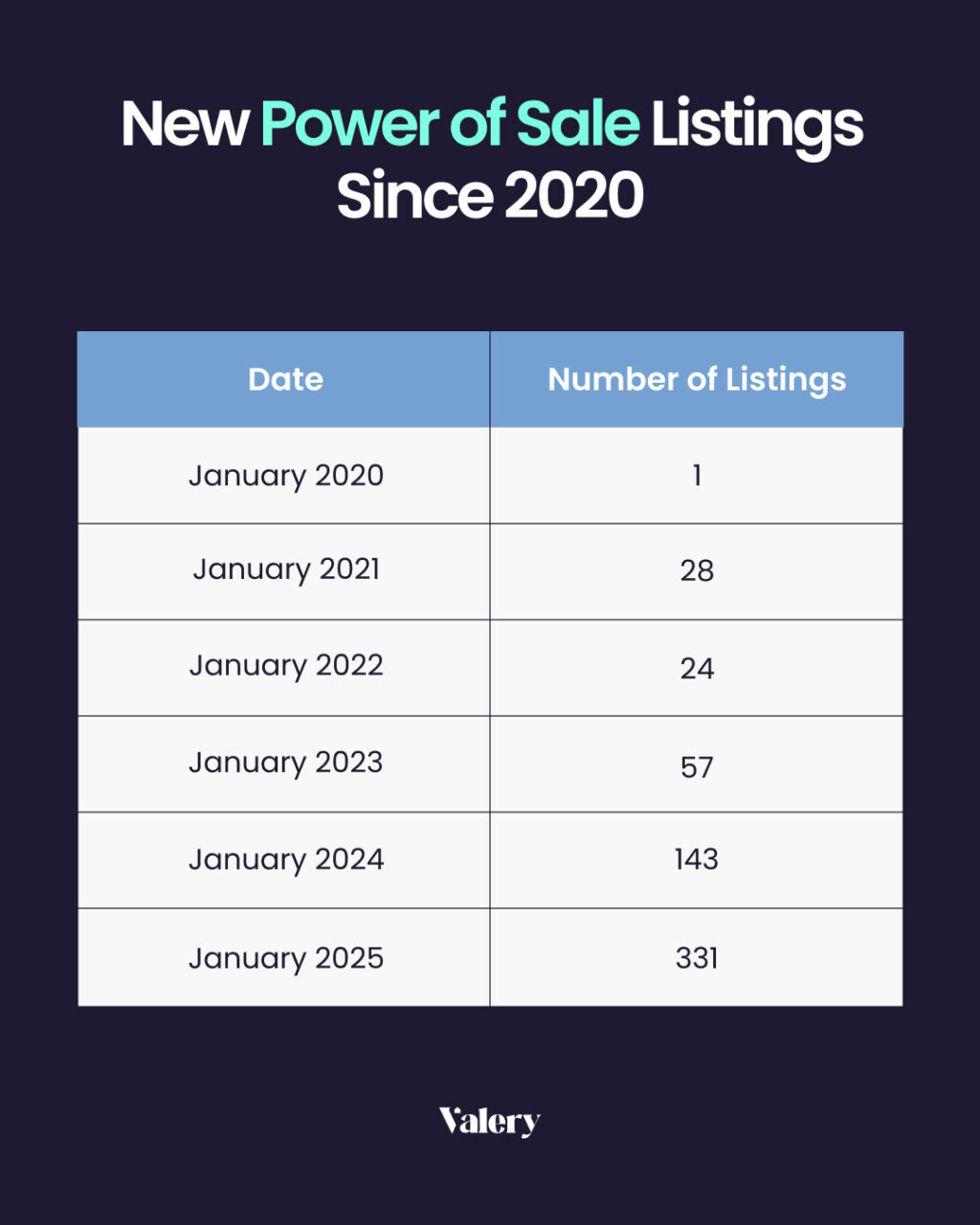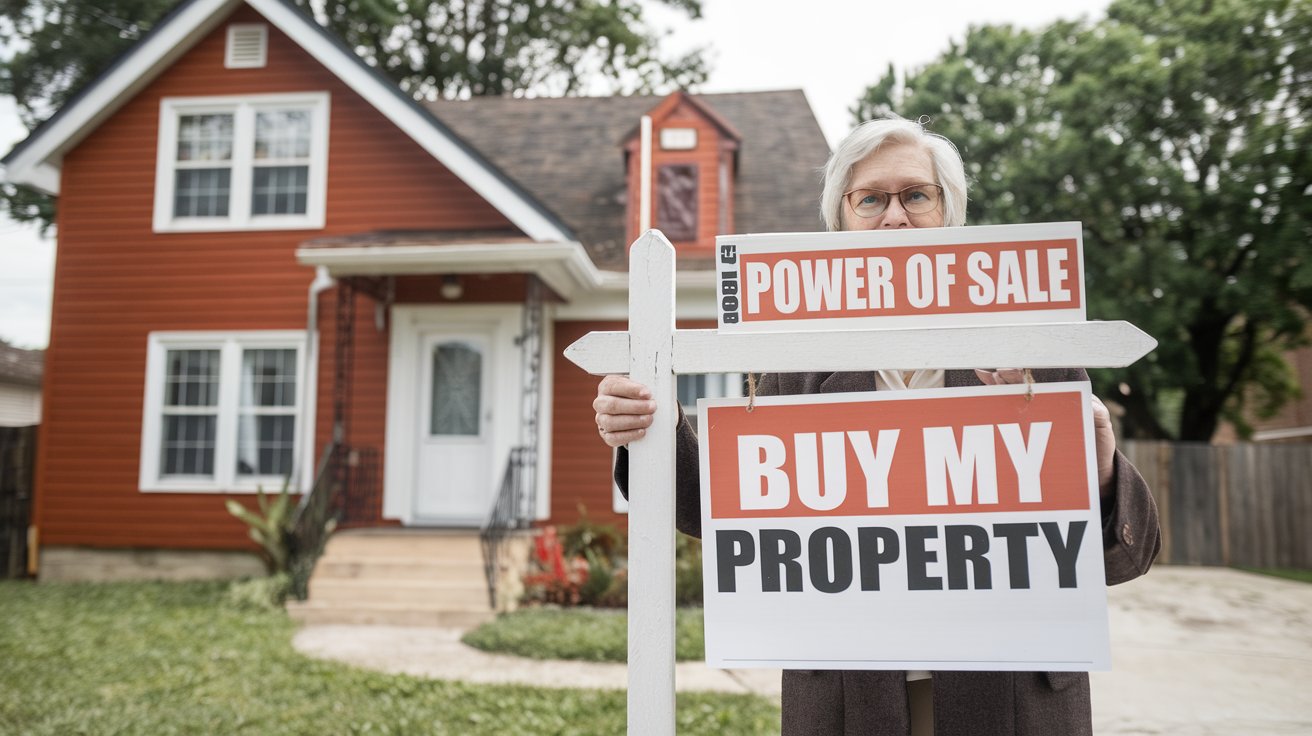Table of Contents
It’s obvious that the Canadian real estate market has experienced significant fluctuations over the past few years, with rising interest rates, economic uncertainty, and affordability challenges affecting both homeowners and potential buyers. One of the most telling indicators of financial strain in the housing sector is the increase in power of sale listings, particularly in areas like the Greater Toronto Area (GTA).
What Is a Power of Sale in Canada?
Power of sale allows mortgage lenders to sell a property when a borrower defaults on their mortgage payments. When a power of sale happens, lenders want to earn back their money that they have lost. The difference between a power of sale vs foreclosure is that the lender doesn’t take ownership of the property but sells it to recover the outstanding debt. On the other hand, when a foreclosure occurs, the lender takes full ownership of the property.
The process varies slightly by province but generally follows a this approach:
- Notice of Sale – The lender must first issue a Notice of Sale to the borrower, providing a redemption period (e.g., 35 days in Ontario) during which the borrower can repay the overdue amount to stop the sale.
- Redemption Period – If the borrower fails to make the necessary payments within this period, the lender proceeds with the sale process.
- Sale of Property – The lender lists and sells the property at fair market value to recover the mortgage balance, legal fees, and other costs.
- Distribution of Proceeds – Any surplus funds after the debt is settled are returned to the borrower. If the sale proceeds are insufficient, the lender may sue the borrower for the remaining balance.
Power of Sale Listings are Surging
The number of power of sale listings in Canada, particularly in the GTA, has surged in recent years. Recent data highlights the following trends:
- 2020: Average of 4.5 power of sale listings per month.
- 2021: Increased to an average of 33 listings per month.
- 2022: Continued rising to 38 listings per month.
- 2023: Jumped significantly to 83 listings per month.
- 2024: Saw an even more dramatic rise, with an average of 159 listings per month.
By September 2024, the number of active power of sale listings in the GTA had doubled compared to the same time in 2023, jumping from 96 to 204 listings.
The number of active listings on the Toronto MLS containing “power of sale” or “mortgage” in the seller name shows key market shifts:
- Low Point: 60 listings in early April 2024.
- High Point: 163 listings in September 2024.
- Current (February 2025): 134 listings.
The data highlights a steady rise in power of sale listings from early 2024, peaking in late 2024, before slightly declining into early 2025. This increase was driven by economic factors such as rising interest rates, inflation, and declining affordability, forcing more homeowners to default on their mortgages. The recent dip suggests that some stability may be returning to the market, possibly due to lower interest rates and improved financial conditions.

Why Is This Happening & What Does It Mean for Buyers?
The increase in power of sale listings is largely driven by rising mortgage costs, financial strain, and shifting market conditions. Over the past two years, many homeowners have been hit hard by higher interest rates, making their mortgage payments unaffordable. Combined with inflation and job market instability, this has resulted in a growing number of distressed properties entering the market.
For buyers, this presents a unique opportunity. These properties are often priced below market value because lenders are looking to earn back their money quickly. Unlike traditional home sellers, lenders are not emotionally invested in the property, meaning they are often more willing to negotiate and accept lower offers.
Is it Smart to Buy a Property Under Power of Sale in Canada and How Would I Do it?
Buying a these properties could be a smart financial move depending on your circumstances. Power of Sale properties are often listed below market value because lenders prioritize selling quickly rather than maximizing profit. The process moves faster than traditional sales since the lender is motivated to recover their money efficiently. Plus, fewer buyers compete for these properties, as many are unfamiliar with the process or hesitate due to the as-is condition – which means you’ll face less competition on these properties.
Here are four reasons why you might want to consider buying a property under Power of Sale:
- Significant Cost Savings – Power of sale properties are often priced lower than comparable homes in the same area. This makes them an attractive option for investors, first-time buyers, and those looking for a deal.
- Faster Closing Process – Since the lender is the seller, transactions are usually completed faster than traditional real estate deals.
- Less Competitive Buying Process – Many buyers avoid power of sale properties due to uncertainty, but working with an experienced team can help navigate the process smoothly.
- Potential for Higher ROI – Investors and homebuyers can add value to these properties through renovations and resale.
However, buying these kinds of homes come with some risks you need to be aware of:
- Properties Are Sold “As-Is” – Unlike traditional sales, the lender does not make any guarantees about the property’s condition.
- Due Diligence Is Essential – Buyers should conduct thorough inspections and title searches before purchasing.
- Competitive Pricing – While these homes can be listed below market value, competition from investors and other buyers can drive up prices.
How to Find the Best Power of Sale Deals
One of the best ways to find these properties is by working with a real estate agent who is experienced in these kinds of deals.
Finding discounted properties requires expertise, and if you’re seriously considering purchasing a home under Power of Sale – Valery Real Estate offers a special service for these kinds of properties. We help buyers identify the best opportunities, assess property conditions, and negotiate the best deals.
If you’re interested in finding a power of sale property in the Greater Toronto Area, sign up to our email list where you’ll get the best deals straight to your inbox for free.
Conclusion
Power of sale has become an increasingly prevalent feature of the Canadian housing market, particularly in Ontario. Rising mortgage rates, inflation, and market corrections have led to a surge in distressed sales, affecting both homeowners and potential buyers.
For homeowners, early intervention, legal advice, and open communication with lenders can help avoid power of sale situations. For buyers, these properties can offer unique opportunities, but due diligence is necessary to ensure a sound investment.
As the market stabilizes in 2025, power of sale trends will likely shift, making it essential for all parties involved to stay informed and adaptable in a changing real estate landscape.
FAQ
1. What is a power of sale in Canada?
A clause in a mortgage agreement allowing the lender to sell the property if the borrower defaults on payments, without needing court approval in many provinces. This gives the lender the authority to take possession and sell the home to recover the outstanding debt.
2. In Canada, how different is power of sale compared to foreclosure?
The main difference lies in the legal process. Power of sale is generally faster and less court-involved, while foreclosure requires court approval. Also, in a power of sale, the homeowner may receive surplus funds after the sale, whereas in a foreclosure, the lender assumes ownership and liabilities.
3. Why are power of sales becoming more common in Canada?
They’re increasing due to rising interest rates, economic instability, or job loss, making it difficult for homeowners to keep up with mortgage payments. These factors can lead to a higher number of mortgage defaults and subsequent power of sale proceedings.
4. Is buying a power of sale property a good investment?
They can be a good deal, but it’s important to do your research. Lenders are required to sell at market value, but properties are sold “as is,” meaning you’re responsible for any repairs. To find these properties, work with a real estate agent familiar with power of sale listings, and be prepared for a potentially complex transaction.
5. Are there alternatives to power of sale I should consider?
Alternatives include working with your lender to modify your mortgage terms, seeking debt counseling, or selling your home yourself to maintain control over the sale price and avoid the power of sale process.





